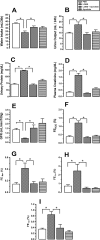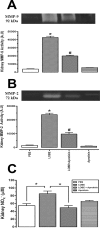Renal and vascular effects of kallikrein inhibition in a model of Lonomia obliqua venom-induced acute kidney injury
- PMID: 30763408
- PMCID: PMC6392336
- DOI: 10.1371/journal.pntd.0007197
Renal and vascular effects of kallikrein inhibition in a model of Lonomia obliqua venom-induced acute kidney injury
Abstract
Background: Lonomia obliqua venom is nephrotoxic and acute kidney injury (AKI) is the main cause of death among envenomed victims. Mechanism underlying L. obliqua-induced AKI involves renal hypoperfusion, inflammation, tubular necrosis and loss of glomerular filtration and tubular reabsorption capacities. In the present study, we aimed to investigate the contribution of kallikrein to the hemodynamic instability, inflammation and consequent renal and vascular impairment.
Methodology/principal findings: Addition of L. obliqua venom to purified prekallikrein and human plasma in vitro or to vascular smooth muscle cells (VSMC) in culture, was able to generate kallikrein in a dose-dependent manner. Injected in rats, the venom induced AKI and increased kallikrein levels in plasma and kidney. Kallikrein inhibition by aprotinin prevented glomerular injury and the decrease in glomerular filtration rate, restoring fluid and electrolyte homeostasis. The mechanism underlying these effects was associated to lowering renal inflammation, with decrease in pro-inflammatory cytokines and matrix metalloproteinase expression, reduced tubular degeneration, and protection against oxidative stress. Supporting the key role of kallikrein, we demonstrated that aprotinin inhibited effects directly associated with vascular injury, such as the generation of intracellular reactive oxygen species (ROS) and migration of VSMC induced by L. obliqua venom or by diluted plasma obtained from envenomed rats. In addition, kallikrein inhibition also ameliorated venom-induced blood incoagulability and decreased kidney tissue factor expression.
Conclusions/significance: These data indicated that kallikrein and consequently kinin release have a key role in kidney injury and vascular remodeling. Thus, blocking kallikrein may be a therapeutic alternative to control the progression of venom-induced AKI and vascular disturbances.
Conflict of interest statement
The authors have declared that no competing interests exist.
Figures









Similar articles
-
Urine proteomic analysis reveals alterations in heme/hemoglobin and aminopeptidase metabolism during Lonomia obliqua venom-induced acute kidney injury.Toxicol Lett. 2021 May 1;341:11-22. doi: 10.1016/j.toxlet.2021.01.012. Epub 2021 Jan 17. Toxicol Lett. 2021. PMID: 33472085
-
Mechanisms of acute kidney injury induced by experimental Lonomia obliqua envenomation.Arch Toxicol. 2015 Mar;89(3):459-83. doi: 10.1007/s00204-014-1264-0. Epub 2014 May 6. Arch Toxicol. 2015. PMID: 24798088 Free PMC article.
-
Effects of Lonomia obliqua Venom on Vascular Smooth Muscle Cells: Contribution of NADPH Oxidase-Derived Reactive Oxygen Species.Toxins (Basel). 2017 Nov 7;9(11):360. doi: 10.3390/toxins9110360. Toxins (Basel). 2017. PMID: 29112156 Free PMC article.
-
Lonomia obliqua venom: In vivo effects and molecular aspects associated with the hemorrhagic syndrome.Toxicon. 2010 Dec 15;56(7):1103-12. doi: 10.1016/j.toxicon.2010.01.013. Epub 2010 Jan 28. Toxicon. 2010. PMID: 20114060 Review.
-
Lonomia obliqua Walker (Lepidoptera: Saturniidae): hemostasis implications.Rev Assoc Med Bras (1992). 2015 May-Jun;61(3):263-8. doi: 10.1590/1806-9282.61.03.263. Rev Assoc Med Bras (1992). 2015. PMID: 26248250 Review.
Cited by
-
Caterpillar Venom: A Health Hazard of the 21st Century.Biomedicines. 2020 May 30;8(6):143. doi: 10.3390/biomedicines8060143. Biomedicines. 2020. PMID: 32486237 Free PMC article. Review.
-
Acteoside ameliorates cerebral ischemia/reperfusion injury in MCAO rats as a natural plasma Kallikrein inhibitor from Osmanthus fragrans flower.Sci Rep. 2025 Jul 2;15(1):23509. doi: 10.1038/s41598-025-06553-1. Sci Rep. 2025. PMID: 40603384 Free PMC article.
-
Effect of Lonomia obliqua Venom on Human Neutrophils.Toxins (Basel). 2021 Dec 18;13(12):908. doi: 10.3390/toxins13120908. Toxins (Basel). 2021. PMID: 34941745 Free PMC article.
-
Lonomia obliqua Venom Induces NF-κB Activation and a Pro-Inflammatory Profile in THP-1-Derived Macrophage.Toxins (Basel). 2021 Jun 30;13(7):462. doi: 10.3390/toxins13070462. Toxins (Basel). 2021. PMID: 34209394 Free PMC article.
-
Estrogen depletion modulates aortic prothrombotic signaling in normotensive and spontaneously hypertensive female rats.Mol Cell Endocrinol. 2023 Feb 5;561:111827. doi: 10.1016/j.mce.2022.111827. Epub 2022 Dec 7. Mol Cell Endocrinol. 2023. PMID: 36494014 Free PMC article.
References
-
- Veiga ABG, Berger M, Guimarães JA. Lonomia obliqua venom: pharmaco-toxicological effects and biotechnological perspectives In: de Lima ME, Pimenta AMC, Martin-Euclairte MF, Zingali RB, Rochat H, editors. Animal Toxins: State of the Art. Perspectives in Health and Biotechnology. Editora UFMG, Belo Horizonte; 2009. pp. 371–390.
-
- Berger M, Vieira MAR, Guimaraes JA. Acute Kidney Injury Induced by Snake and Arthropod Venoms In: Polenakovic M, editor. Renal Failure—The Facts. ISBN: 978953-51-0630-2, InTech-Open, Rijeka, Croatia; 2012. pp. 157–186.
Publication types
MeSH terms
Substances
LinkOut - more resources
Full Text Sources
Other Literature Sources

